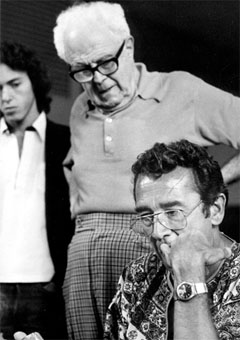|
| Magriel's NYT Columns |

Oswald Jacoby looks on as Gino
Scalamandre is playing. For decades, Oswald Jacoby has been known worldwide as a master of many games. He has been in the forefront of international bridge competition since the 1930’s, and he has collected numerous bridge and backgammon titles, including the World Backgammon Championship in 1973. In addition, he has written authoritative works on canasta, gin rummy, and poker, as well as the first outstanding modern backgammon book.
Now in his 70’s, he still maintains a pace that frequently wears out younger opponents. To Jacoby, trained as an actuary, mathematical probabilities in games are second nature.
In the diagrammed position, Jacoby (Black) displayed his skillful technique using his knowledge of the odds in backgammon. White has already doubled and has reached a winning position, having borne 11 men off. Although Black has no chance to win, the game continues, to see whether Black will lose a double game (or gammon).
|
| Black to play 6-1. |
The general rule for saving the gammon is to bring all your men into your home board as quickly as possible. In so doing, it is critical not to waste any pips inside your home board. However, exceptions to this principle do occur, particularly when there is only one roll left to play, as in this position. In these one-roll positions, there are no rigid guidelines to determine the best play. The alternatives must be computed on a roll-by-roll basis and the resulting odds compared.
Assume first that Black plays 16/9, following the general rule by moving his back man as close to his home board as possible. In the resulting position, should Black roll 1 on either die, he will not be able to take a man off. He will have to use the larger number to take his man from the 9-point into his home board; but he will be unable to bear a man off, because he has no men on the 1-point.
The odds of Black rolling a 1 on either die are 11 out of 36. How can he reduce his chances of being gammoned?
The correct play is 16/10, 2/1, moving the back man six pips forward and filling the void on the 1-point by “wasting” a pip inside. Now, on Black’s next roll, only 7 combinations out of 36 (1-1, 1-2, 1-3, 2-3) gammon him — certainly better odds than the first alternative.
Jacoby made the correct play and was rewarded for his careful analysis. In the game, he next rolled a 5-1, and saved the gammon by bringing his last man in and bearing a man off the 1-point. Had he made the other play, he would have indeed been gammoned, losing 4 points instead of 2.
In backgammon, many extra points are squandered through careless play, especially in situations in which the game is already lost.
Rollout
 Tom Keith 2013 |
|
Money play Black owns 2-cube Black rolls 6-1 1296 games with VR Checker play: 2-ply Cube play: 3-ply Red |
| 6-1: | Game | G | BG | Equity | ||||
| 1 | 16/10, 2/1 |
W L |
.0000 1.000 |
.0000 .3286 |
.0000 .0000 | −1.3286 |

| (b) |
| 2 | 16/9 |
W L |
.0000 1.000 |
.0000 .4213 |
.0000 .0000 | −1.4213 | (0.0927) | (a) |

|
|

